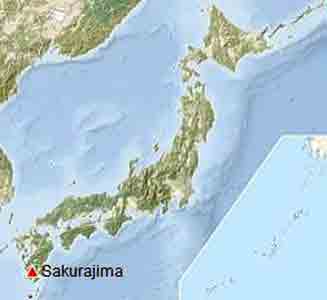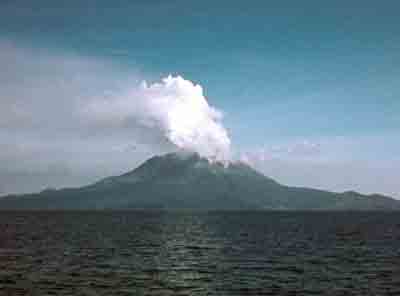Volcanic Ash sample Raw Minerals Lapilli Pumice Lava Bombs Stones Rocks for Collection.
Rare collection of medium grained volcanic Sand from the Sakurajima's Volcano eruption, in Japan.
Available on our website, besides ashes, pumice and bombs, also various volcanic rocks, such as Apache Teardrops, sulfur, obsidian, tuff, crystal chalk, etc.
Volcanic ash consists of small tephra, which are bits of pulverized rock and glass created by volcanic eruptions, less than 2 millimetres (0.1 inch) in diameter . Ash is created when the usually violent nature of an eruption involving steam results in the magma and solid rock surrounding the vent being torn into particles of clay to sand size.
Every ash samples is labelled and bagged in a vial with cap (mm 20 x 5), so thay can easily be removed if required for study under a microscope.
As with all volcanic ash, the material should be handled with care and not inhaled.
The Sakurajima (桜 島) is an active volcano, as well as the island of the same name (now joined to the mainland) in the Prefecture of Kagoshima (鹿 児 島), in Japan (日本) south-west.
It is a stratovolcano with the peak divided into three peaks: the Kitadake (北岳) to the

north (inactive for at least 4,900 years, is the highest: 1,117 m asl), the Nakadake (中岳) in the middle and the Minamidake (南岳) in the south , only peak still active. The surface of the island is about 77 square kilometers. The mountain is located in a part of the Kagoshima Bay called Kinko Bay (錦江 湾); in addition, the island itself is part of the city of Kagoshima. The name, translated from Japanese, means "cherry island" (sakura = cherry, jima or shima = island), because of the abundant presence of these trees.
In 1914, the volcano had a violent eruption that buried the surrounding villages from lava, and whose deposit joined the island to the nearby Peninsula of Osumi (大 隅 半島). The volcanic activity continues today, and consists mainly in the emission of ash that covers the surroundings of the mountain, in addition to Kagoshima itself.
In 2013 the eruptive activity resumed with ash columns rising to 5,000 meters and then pouring over the town of Kagoshima.
The Sakurajima is located in the caldera of Aira (姶 良 カ ル デ ラ), more than 20 km in size and formed due to a catastrophic eruption some 22,000 years ago. On that occasion several hundred cubic km of ash and pumice were expelled, causing the pre-existing volcanic building to sink into the magma chamber, then invaded by sea water, and creating the vast expanses of white sand in the region. The volcano, which has an approximate age of 15,000 years (therefore, geologically very young), rises 8 km south of the center of the caldera, and the first documented historical eruption dates back to 963 AD. Most of the eruptions are of Strombolian type (concerning, that is, only the summit parts), but large plinian eruptions (highly destructive) occurred in 1471-76, 1779-82 and 1914.
The eruption of 1914 was the most powerful volcanic eruption of the twentieth century ever in Japan, and the castings produced in it joined the volcano to the mainland. Before that year, the volcano had been quiescent for more than a century. The US volcanologist Frank A. Perret was the witness of the event.
The eruption began on 11 January 1914. Alarmed by the frequent earthquakes that had been increasingly felt for some time, the population had already made it safe. The volcano first manifested a series of strong explosions that created a very high eruptive cloud, then generated massive lava flows that soon reunited in a single river of molten magma. On January 13, a violent earthquake killed 35 people. During the final phase of the eruption, the Aira Caldera collapsed due to the subsidence of the ground due to the emptying of the magma chamber. The fact that this subsidence occurred at the center of the caldera, and not under the Sakurajima itself, testifies that the volcano is supplied with magma from the same "pockets" that fed the ancient caldera.

After 1914, the Sakurajima again erupted in 1955, forcing the inhabitants to leave the area again. Five years later, the homonymous Vulcanological Observatory was erected on the mountain, in order to monitor the volcano and to forecast its eruptions: in the area around it there are no less than 680,000 people, and Kagoshima itself is only 8 km from the mouth of the volcano. Special shelters have been built around the city, safe from pyroclastic flows and the rain of the lapilli, where people can get safely in the shortest possible time thanks to highly efficient and efficient evacuation plans, which take off with the sound of a siren.
After the last significant eruption in 1991 and the most recent eruptions of May 2009 and August 2013, Sakurajima entered a project that involves the in-depth study of 16 volcanoes, scattered around the Earth, whose geological-environmental conditions can be useful for understanding the eruptive dynamics and disasters associated with them. The Sakurajima is currently part of the Kirishima-Yaku National Park (霧 島 屋 久 国立 公園), and is a regular destination for many tourists.



